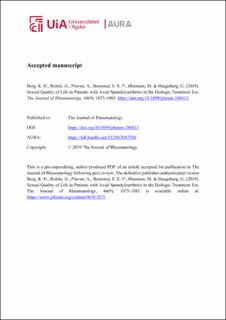| dc.contributor.author | Noori, Nadia | |
| dc.contributor.author | Shanbhag, Vignesh Vishnudas | |
| dc.contributor.author | Kandukuri, Surya Teja | |
| dc.contributor.author | Schlanbusch, Rune | |
| dc.date.accessioned | 2023-05-02T11:51:23Z | |
| dc.date.available | 2023-05-02T11:51:23Z | |
| dc.date.created | 2022-07-06T13:57:16Z | |
| dc.date.issued | 2022 | |
| dc.identifier.citation | Noori, N., Shanbhag, V. V., Kandukuri, S. T. & Schlanbusch, R. (2022). Data Driven Seal Wear Classifications using Acoustic Emissions and Artificial Neural Networks. Proceedings of the European Conference of the Prognostics and Health Management Society (PHME), 7(1), 368-375. doi: | en_US |
| dc.identifier.issn | 2325-016X | |
| dc.identifier.uri | https://hdl.handle.net/11250/3065755 | |
| dc.description.abstract | The work presented in this paper is built on a series of experiments aiming to develop a data-driven and automated method for seal diagnostics using Acoustic Emission (AE) features. Seals in machineries operate in harsh conditions, and seal wear in hydraulic cylinders results in fluid leakage, and instability of the piston rod movement. Therefore, regular inspection of seals is required using automated approaches to improve productivity and to reduce unscheduled maintenance. In this study, we implemented a data-driven diagnostics approach which utilizes AE measurements along with light weight Artificial Neural Networks (ANN) as a classifier to investigate the performance and resources (hardware & software) required for implementing a real-time soft sensor unit for monitoring seal wear condition. We used a feedforward multilayer perceptron ANN (Scaled Conjugate Gradient- SCG algorithm) that is trained with the back propagation algorithm, which is a popular network architecture for a multitude of applications (automotive, oil and gas, electronics). We benchmark the developed method against previous work conducted based on Support Vector Machine (SVM), and we compare ANN performance in classifying the running condition of seals in hydraulic cylinders by applying it to both raw (full frequency spectrum) and down sampled frequency measurements. The experiments were performed at varying pressure conditions on a hydraulic test rig that can simulate fluid leakage conditions like that of hydraulic cylinders. The test cases were generated with seals of three different conditions (unworn, semi-worn, worn). From the AE spectrum, the frequency bands were identified with peak power and by heterodyning the signal. This technique results in 10X down sampling without losing the information of interest. Further, the signal was divided into smaller “snapshots” to facilitate rapid diagnosis. In these tests, the diagnosis was made on short-time windows, as low as 0.3 seconds in length. A general set of 16 time and frequency domain features were designed. Then a training set was developed using relevant set of features (4, 5, and 16 features). The data was used to train the ANN (70% training – 30% test & validation) and SVM (60 % training - 40% test and validation). Classification of down sampled measurements, both ANN and SVM were able to accurately classify the status irrespective of the pressure conditions, with an accuracy of ~99% with execution time less than seconds. Therefore, the proposed approach can be applied as part of an automated seal wear classification technique based on AE and ANN/SVM and can be used for real-time monitoring of seal wear in hydraulic cylinders. | en_US |
| dc.language.iso | eng | en_US |
| dc.publisher | The Prognostics and Health Management Society (PHM Society) | en_US |
| dc.relation.uri | file:///C:/Users/miri/AppData/Local/Temp/MicrosoftEdgeDownloads/970c2565-b63d-4a83-9d67-f99dd466c44b/3327-Document%20Upload-11056-1-10-20220630.pdf | |
| dc.rights | Navngivelse 4.0 Internasjonal | * |
| dc.rights.uri | http://creativecommons.org/licenses/by/4.0/deed.no | * |
| dc.title | Data Driven Seal Wear Classifications using Acoustic Emissions and Artificial Neural Networks | en_US |
| dc.type | Peer reviewed | en_US |
| dc.type | Journal article | en_US |
| dc.description.version | publishedVersion | en_US |
| dc.rights.holder | © 2022 The Author(s) | en_US |
| dc.subject.nsi | VDP::Teknologi: 500 | en_US |
| dc.source.pagenumber | 368-375 | en_US |
| dc.source.volume | 7 | en_US |
| dc.source.journal | Proceedings of the European Conference of the Prognostics and Health Management Society (PHME) | en_US |
| dc.source.issue | 1 | en_US |
| dc.identifier.doi | 10.36001/phme.2022.v7i1.3327 | |
| dc.identifier.cristin | 2037394 | |
| dc.relation.project | Norges forskningsråd: 237896 | en_US |
| cristin.qualitycode | 1 | |

